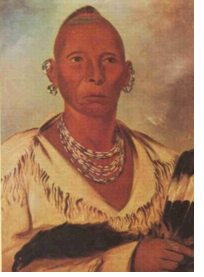Black Hawk
(Ma-ka-tai-me-she-kia-kiak)
Leader of the Sauk and Fox Indians, b. 1767 (Sauk Sautenuk, North America), d. 3 October 1838 (Des Moines River, Iowa, USA).
 Ma-ka-tai-me-she-kia-kiak (Black Sparrow Hawk), known to the white settlers and the USA authorities as Black Hawk, was a chief of the Sauk and Fox Indians, who had lived in the fertile river valleys of Illinois. During the first decades of the 19th century the Sauk and Fox lands were settled by "pioneer farmers" supported by the government of the USA
Ma-ka-tai-me-she-kia-kiak (Black Sparrow Hawk), known to the white settlers and the USA authorities as Black Hawk, was a chief of the Sauk and Fox Indians, who had lived in the fertile river valleys of Illinois. During the first decades of the 19th century the Sauk and Fox lands were settled by "pioneer farmers" supported by the government of the USA
The Sauk nation signed a treaty in 1795, which promised protection by the United States. But more settlers arrived, and in 1804, after a fight lead to the death of three settlers, some Sauk chiefs travelled to St. Louis to arrange a permanent peace. They were given much alcohol and then signed a treaty that sold 20 million hectares to the USA for $2,274.50.
Black Hawk declared the treaty invalid because it was signed without consultation with the Sauk nation. In an attempt to stop the influx of more settlers he sided with the Britsh troops when war flared up again in 1812, during the final years of the War of Independence.
During the following twenty years the USA initially managed to keep Black Hawk relatively isolated by supporting the rival chief Keokuk. But as more and more settlers invaded Indian land and the discovery of lead brought an influx of miners, large parts of the Sauk and Fox tribes began to look to Black Hawk as their leader.
In 1832 Black Hawk took some 1,000 Sauk and Fox Indians across the Mississippi back to Illinois, from where they had been driven into Iowa the year before, to reclaim their land. It was a group of many families, including women and children, and clearly not a war expedition, but the USA dispatched troops to meet them. The government also ordered Black Hawk to abandon the fertile Sauk and Fox cornfields and villages along the Rock River, but he refused.
The first engagement with Illinois militia resulted in a victory for the Indians, but the arrival of federal troops soon forced Black Hawk to retreat towards the Mississippi, where he found a steamboat with soldiers waiting for him. He raised a white flag as a sign of surrender, but this was not accepted. When the pursuing troops arrived the next day, the Sauk were trapped. Eventually the troops met with Black Hawk's people at Bad Axe River in Wisconsin and massacred most of them. Less than 150 of the 500 Sauk men, women and children survived.
Black Hawk escaped but was captured and handed over to Keokuk as a hostage. The USA confiscated all Sauk and Fox land in Illinois and eastern Iowa and the land of the Winnebago in southern Wisconsin. Other Indian tribes were so shocked by the brutality of the massacre that they fled to the far west of North America, effectively allowing white settlers to occupy the Northwest Territory without further Indian opposition. Black Hawk lived for another few years, a broken man. In one of his last public appeareances he said: "A few summers ago, I was fighting against you. I did wrong, perhaps, but that is past. It is buried. Let it be forgotten. Rock river was beautiful country. I loved my towns, my cornfields, and the home of my people. It is yours now. Keep it as we did."
The struggle of Black Hawk is told in The Life of Ma-ka-tai-me-she-kia-kiak published in 1833. Abraham Lincoln participated in the "Black Hawk War" of 1832 as a volunteer.
Reference
Encyclopaedia Britannica 15th ed. (1995) Black Hawk.
home
 Ma-ka-tai-me-she-kia-kiak (Black Sparrow Hawk), known to the white settlers and the USA authorities as Black Hawk, was a chief of the Sauk and Fox Indians, who had lived in the fertile river valleys of Illinois. During the first decades of the 19th century the Sauk and Fox lands were settled by "pioneer farmers" supported by the government of the USA
Ma-ka-tai-me-she-kia-kiak (Black Sparrow Hawk), known to the white settlers and the USA authorities as Black Hawk, was a chief of the Sauk and Fox Indians, who had lived in the fertile river valleys of Illinois. During the first decades of the 19th century the Sauk and Fox lands were settled by "pioneer farmers" supported by the government of the USA